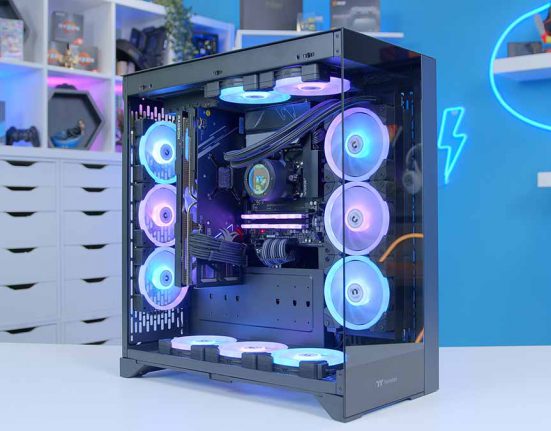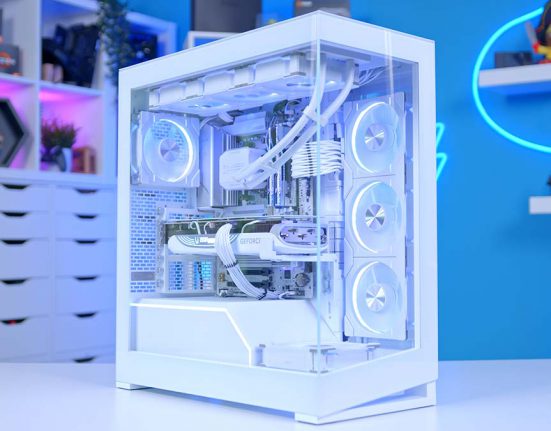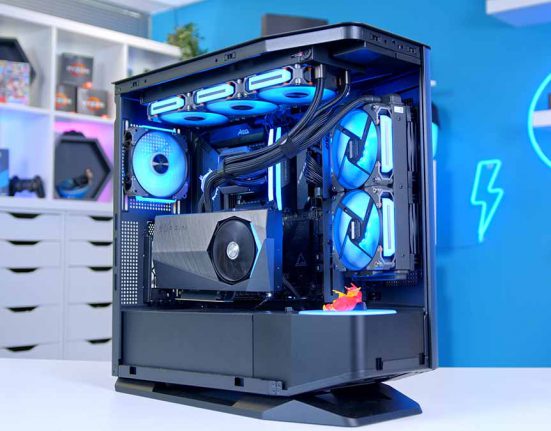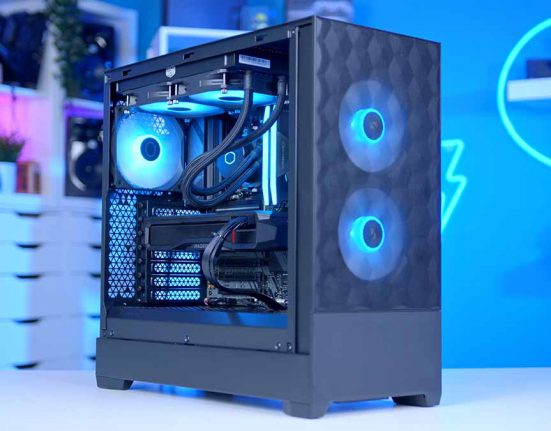Introduction
Intel’s Core i9 13900K is one of the most powerful CPUs available on the market right now. If you’re looking to build a multifaceted workstation PC that has plenty of cores designed to handle high intensity productivity applications. The high clock speed and strong single core capability also makes this CPU a perfect option for top-end gaming when paired up with a strong GPU option.
Speaking of which, what are the best graphics cards to pair up with this absolute titan of a processor? Is the RTX 4090 the best option, to ensure your export times are low and your framerates are high? Or is AMD‘s RX 6950 XT a better choice for the price conscious buyer just looking to play some games?
In this buyers guide article we’ll be answering these very questions with a roundup of the best graphics card to pair up with the Core i9 13900K. We’ll be taking a look at some GPU recommendations, and we’ll also be addressing some major questions in the PC gaming and hardware space.
Suggested Article: Intel Core i9 13900K Review & Benchmarks – The Best Gaming CPU Ever Made
Our Recommendations
1. AMD Radeon RX 6950 XT
👑 The best budget 4K gaming option for the Core i9 13900K.
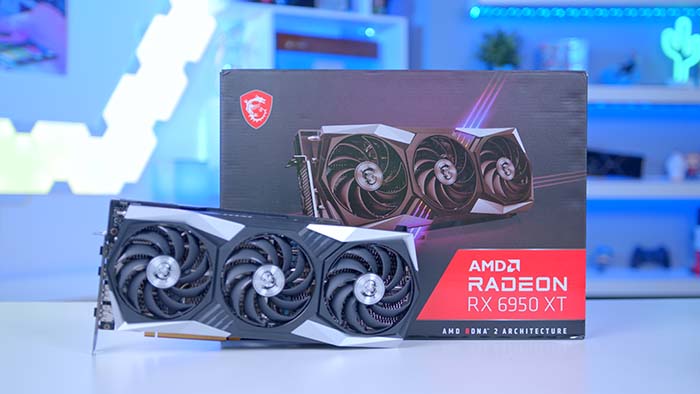
Introduction
First off in this roundup is AMD‘s RX 6950 XT, a titan from the previous generation’s Radeon 6000 refresh. During the initial Radeon 6000 refresh we were a little bit disappointed with the performance metrics of this card, as there didn’t seem to be much of a gaming improvement versus the current competition at the time. A multitude of RTX 3000 cards were still beating out this option and many of them were cheaper, or at a similar price point that made them a worthwhile consideration.
Fast forward to now, and the RX 6950 XT is an excellent value-proposition versus current, and old-gen options. Consumers can expect to play 4K games without any hindrances. Ray-Tracing performance is also pretty solid too, with the 6950 XT competing with some NVIDIA GPUs. And to top it all off, this card is insanely cheap. The RX 6950 XT is nearly half-price from some vendors, which is insane, considering the fact that this is a 4K capable graphics card.
Key Specs
| Key Specs | AMD Radeon RX 6950 XT |
|---|---|
| Video Memory | 16GB GDDR6 |
| Base Clock Speed | 1.89GHz |
| Boost Clock Speed | 2.31GHz |
| Stream Processors | 5120 |
| Ray Accelerators | 80 |
| Power Consumption | 335W |
Things We Like
Excellent 4K gaming performance: The RX 6950 XT is an excellent option for those looking to pick up a 4K capable gaming GPU. You’ll be able to max out all of your settings without any stutters, and enjoy plenty of high framerates.
Extremely competitive price: The 6950 XT is one of the cheapest 4K graphics card, and can be picked up for a very reasonable price. If you’re being price conscious about your spending, this will be a great card to consider.
Things We Don’t Like
Can be quite large: Unfortunately, the more powerful your GPU is, the larger they tend to become. This means that the RX 6950 XT is quite large and other AIBs tend to follow suit, so you’ll need to be careful with your case choices.
NVIDIA cards are better for Ray-Tracing: Although I’d say that the 6950 XT is a solid option when it comes to Ray-Tracing, NVIDIA cards are generally better. If you’re looking for the best Ray-Tracing capable options, we’d urge you to look at the RTX 4000 range to ensure the best performance.
Summary
AMD’s Radeon RX 6950 XT is one of the most competitive 4K capable gaming graphics cards on the market right now. This card is available for nearly half the original MSRP cost, and offers extremely strong metrics in pretty much everything you throw it at, including workstation applications. This card is definitely worth considering if you’re looking for a cheap, but well-rounded option.
Features: 4/5
Design: 4/5
Performance: 4.5/5
Value for Money: 4.8/5
Pros
- Excellent 4K gaming performance.
- Strong workstation capability.
- Competitive price point.
Cons
- NVIDIA cards are generally better for Ray-Tracing.
- The cards are quite large.
Where to Buy
Buy the AMD Radeon RX 6950 XT on:
2. NVIDIA GeForce RTX 4080
👑 The best Ray-Tracing card for the Core i9 13900K.
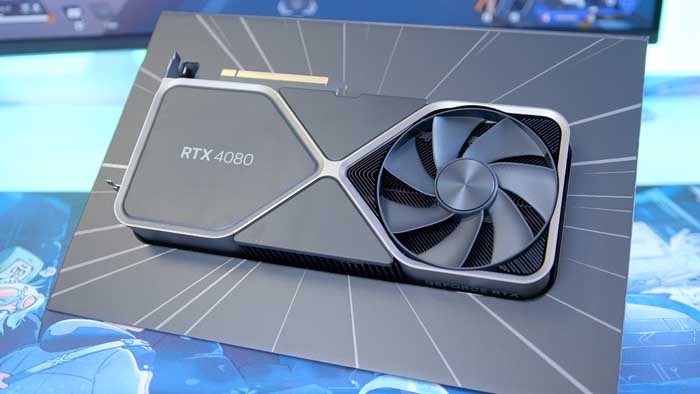
Introduction
Next up in our roundup is the RTX 4080 from NVIDIA. This card has been a bit of a controversial option in the PC hardware space due to the obscene MSRP of this card. But disregarding this, the RTX 4080 is actually a pretty solid option if you’re willing to swallow the price. Unfortunately, this GPU comes in at around $1200 in terms of MSRP, which is the cost of a decent mid-range build, dependent on the components that you’ve chosen. Regardless, this GPU is not a remotely cheap option, and you’ll definitely need to shell out a lot if you’re wanting to pick up this card.
Performance wise the RTX 4080 is one of the strongest 4K capable graphics cards on the market, with solid Ray-Tracing performance. This card is also a great choice for those wanting to build a multifaceted workstation system. The strong hardware and AV1 encoders will allow consumers to significantly reduce export times across a number of applications.
Key Specs
| Key Specs | NVIDIA GeForce RTX 4080 |
|---|---|
| Video Memory | 16GB GDDR6X |
| Base Clock Speed | 2.21GHz |
| Boost Clock Speed | 2.51GHz |
| CUDA Cores | 9728 |
| Power Consumption | 320W |
| RT Cores | 76 |
Things We Like
Ideal for Ray-Tracing: The RTX 4080 is one of the strongest gaming cards, especially if you’re the kind of consumer that enjoys maxing out all of their settings. This GPU can easily handle Ray-Tracing, and is perfect for modern top-end gaming.
Perfect as a workstation GPU: The Ada Lovelace architecture is extremely powerful, and the RTX 4080 makes use of this incredibly well with strong export and render times across the board.
Things We Don’t Like
Very very expensive: Unfortunately, the RTX 4080 is one of the weaker cards when it comes to pricing. This GPU is around double the price of the previous generation’s RTX 3080, putting it well over the $1000 mark.
Size may restrict case choices: NVIDIA’s RTX 4080 is no small graphics card, with the Founders Edition sitting over 300mm in length out of the box. If you’ve got a smaller case, you may run into some clearance issues that could prevent you from installing your GPU.
Summary
NVIDIA’s RTX 4080 is a solid 4K and Ray-Tracing capable graphics card that also doubles as an excellent workstation PC. Whilst this GPU is pretty expensive, and definitely not geared towards those on a budget. Ultimately if you can’t afford this card, there are other solid options that will suit your use-case, but if you’re happy to swallow the price, it’s a worthwhile consideration.
Features: 4/5
Design: 4/5
Performance: 4.5/5
Value for Money: 4.2/5
Pros
- Excellent 4K gaming performance.
- Perfect for Ray-Tracing.
- Ideal as a multifaceted workstation GPU.
Cons
- Very expensive.
- Size may cause clearance problems in smaller cases.
Where to Buy
Buy the NVIDIA GeForce RTX 4080 on:
[adrotate banner=”9″]3. AMD Radeon RX 7900 XTX
👑 The best AMD workstation GPU for the Core i9 13900K.

Introduction
For our third selection, we’ve chosen the Radeon RX 7900 XTX, which is one of AMD‘s more recent innovations from their Radeon 7000 line-up. This GPU is the direct competitor for the RTX 4080, but comes in at a somewhat more palatable price point in comparison. The 7900 XTX released in December of 2022 with an MSRP of $999, which is a fair bit under the price of the RTX 4080. Prices have dropped a little bit since then, but due to the popularity, this card has more or less stayed the same price, with a few drops here and there.
Performance wise, as I’ve alluded to above, the 7900 XTX is the direct competitor to the RTX 4080 and thus, performance is very similar overall. Consumers can expect excellent 4K gaming performance, with relatively decent legs in Ray-Tracing. This card can’t quite compete with the RTX 4080 when it comes to Ray-Tracing, but it is still a solid option, especially when FSR is enabled.
Key Specs
| Key Specs | AMD Radeon RX 6950 XT |
|---|---|
| Video Memory | 24GB GDDR6 |
| Base Clock Speed | 1.85GHz |
| Boost Clock Speed | 2.5GHz |
| Stream Processors | 6144 |
| Ray Accelerators | 96 |
| Power Consumption | 355W |
Things We Like
Strong 4K gaming performance: The RX 7900 XTX is one of the strongest AMD cards available on the market right now. Consumers can expected unhindered top-end 4K gaming performance, with decent legs in Ray-Traced titles too.
Better priced than the RTX 4080: If you’re the kind of consumer making price conscious purchases, the 7900 XTX is a considerably cheaper option versus the RTX 4080. Definitely worth a consideration if you’re looking to spend less on a top-end GPU.
Things We Don’t Like
Still pretty expensive: Although the 7900 XTX is still a cheaper card versus the RTX 4080, this GPU is by no means cheap. Consumers can expect to spend up to $1000 to secure this graphics card.
Weaker as a Ray-Tracing capable card: AMD have been catching up when it comes to Ray-Tracing, but they’re still a fair bit behind in comparison to NVIDIA. If you’re looking for the best Ray-Tracing performance, we’d recommend looking at some alternative NVIDIA cards.
Summary
AMD’s Radeon RX 7900 XTX is a solid card and great option for consumers looking for top-end performance, but at a somewhat more reasonable price point. This card can easily handle 4K gaming, whilst offering solid workstation capability too. Although this card isn’t quite able to compete with some of NVIDIA’s options when it comes to Ray-Tracing, it is still worth taking a look at if you’re looking to spend a little bit less money for a top-end GPU.
Features: 4/5
Design: 4/5
Performance: 4.4/5
Value for Money: 4.4/5
Pros
- Brilliant 4K gaming performance.
- Ideal as a workstation or gaming GPU.
- Cheaper than much of the competition.
Cons
- A rather expensive card.
- Not the best option for Ray-Tracing.
Where to Buy
Buy the AMD Radeon RX 7900 XTX on:
4. NVIDIA GeForce RTX 4090
👑 The best workstation option for the Core i9 13900K.
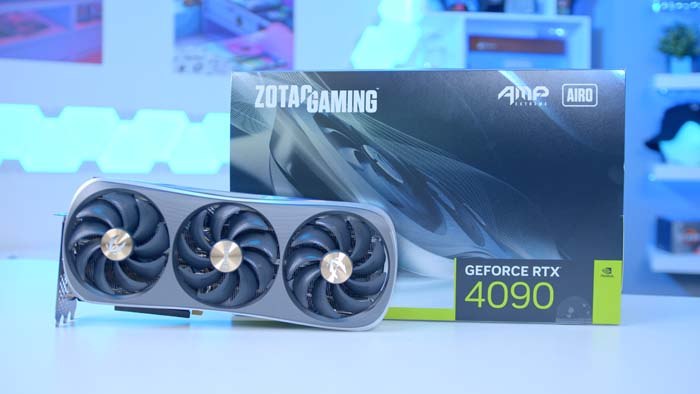
Introduction
For our fourth and final recommendation, we’ve picked out NVIDIA‘s most powerful GPU that we’ve seen in recent years, the RTX 4090. Out of the current RTX 4000 SKUs, the 4090 is the only card to have sold out instantly, and is still one of the most popular (but also the most expensive) cards on the market. This was NVIDIA’s flagship option, and is the strongest card that you can pick up right now. This is the kind of GPU that you would pick up for a top-end workstation system, or if you’re the kind of consumer looking to get the most amount of frames as possible with all of your settings maxed out.
As you can probably expect, this card is not cheap at all. The RTX 4090 launched with an MSRP of around $1599, and has since dropped to $1579 with some options falling just below this. Ultimately, this is an insanely expensive card, and not geared towards the faint of heart, however, if you’re willing to swallow the ridiculous price, I’d argue that you get what you pay for.
Key Specs
| Key Specs | NVIDIA GeForce RTX 4090 |
|---|---|
| Video Memory | 24GB GDDR6X |
| Base Clock Speed | 2.23GHz |
| Boost Clock Speed | 2.52GHz |
| CUDA Cores | 16384 |
| Power Consumption | 450W |
| RT Cores | 128 |
Things We Like
Can handle pretty much anything: The RTX 4090 is one of the most capable graphics cards on the market. Whether you’re building a gaming system, or a workstation PC, this is the GPU to handle it.
Perfect for top-end gaming: This GPU can easily cope with modern games, with all of the settings maxed out. If you’re looking to play all of your games at the best visual fidelity possible, the RTX 4090 will definitely be the best option for this.
Things We Don’t Like
Insanely expensive: The RTX 4090 is a ridiculously expensive card, coming in at an MSRP of around $1600. Needless to say, if you’re on a budget this won’t be the card to pickup.
Not a small GPU: This graphics card is absolutely gigantic. If you’re planning on picking up a smaller case to install this GPU in, you’ll want to think again, as it likely won’t fit. We recommend doing your research on your case clearance before picking up this titan.
Summary
NVIDIA’s RTX 4090 is the most powerful graphics card of this generation. This GPU can handle pretty much everything you throw at it including Ray-Tracing, or intensive workstation applications. If you’re planning on building a multifaceted workstation PC, with some gaming in the evening, this GPU is the card to pick up for your build.
Features: 4/5
Design: 4/5
Performance: 5/5
Value for Money: 4.5/5
Pros
- Excellent 4K and Ray-Tracing performance in modern titles.
- Ideal for a workstation system.
- The most powerful GPU on the market.
Cons
- Very very expensive.
- Will need to research case choices to avoid clearance issues.
Where to Buy
Buy the NVIDIA GeForce RTX 4090 on:
[adrotate banner=”12″]Is the Core i9 13900K A Good CPU?
Much like NVIDIA’s RTX 4090, the Core i9 13900K is one of the most powerful CPUs that you can pick up either for gaming or for a workstation system. There are only a few CPUs that come remotely close to the performance of this processor, and these options will be of a similar price, but are generally weaker processors due to the lower core count. There are a multitude of reasons as to why the 13900K is such an excellent option, and I’ll explain them briefly below.
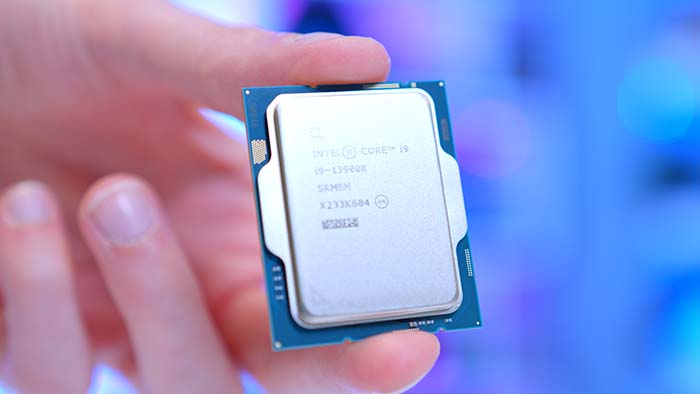
Firstly is the high core and thread count. This is more geared towards productivity systems, but if you need a mass of CPU cores, but you’re not wanting to pick up a Threadripper, then the 13900K is an excellent option. This CPU comes equipped with 24 cores and 32 threads, so it should be perfect for intense applications that need more cores to deal with complicated tasks. Although this isn’t necessarily applicable to gaming, this CPU is a definitive choice for productivity focused PCs.
Alternatively, the 13900K also has an insanely high clock speed, which will provide a massive boost to single core performance. This also makes it ideal for gaming, as the majority of games will thrive much more with a stronger single core experience. Although gaming is heavily reliant on your GPU, your CPU will work in synergy to ensure a high framerate, and a CPU with a higher clock speed will do just that. To summarise, the Core i9 13900K is one of the few options that can handle top-end gaming, whilst also providing strong enough hardware to support high intensity workstation applications.
Do I Need PCI-E 5.0 For My New GPU?
In short, no… but you might do in the future. All of the current GPUs that you can pick up from both AMD and NVIDIA are all PCI-E 4.0 capable options, so these cards will use the bandwidth that PCI-E Gen4 can provide. Recently, there have been a multitude of new motherboards enter the market sporting the new standard of PCI Express, which gave us a bit of an indicator that the latest generation of graphics cards was going to utilise PCI-E 5.0, but this wasn’t the case. NVIDIA have made a shift over to the ATX 3.0/PCI-E 5.0 power connector with their RTX 4000 range, but AMD have retained the standard 6-Pin and 8-Pin designs that we’re used to.
Why have NVIDIA made this change? Because of power consumption. The new ATX 3.0 connector can pipe up to 600W of power within one cable, which minimises the amount of cables and connectors you’ll need in order to power your graphics card. This does point towards their newer cards being even more power hungry, but there aren’t actually any cards on the market that fully utilise this new standard and max out the amount of power that can be drawn.
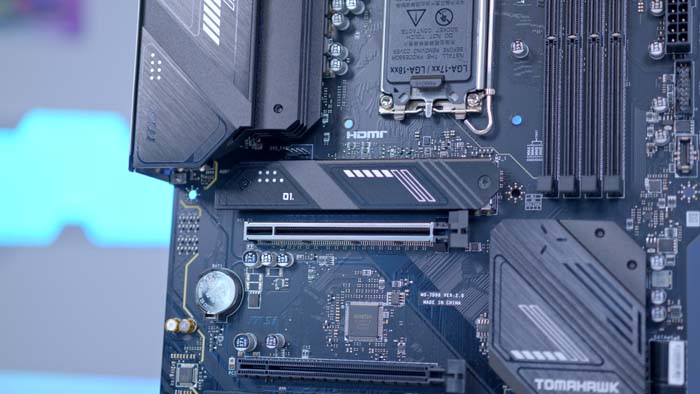
With all of this in mind, it could be a potentially good decision to pick up a motherboard and a power supply that utilises the new standard if you plan on upgrading to the newest generation of GPUs. Although the new range of NVIDIA and AMD cards aren’t likely to land anytime soon, it is highly possible that these cards will need more bandwidth and require even more power, which raises some concerns, but we’ll have to see what the new generation of graphics cards holds. Regardless, we’d definitely recommend picking up some PCI-E 5.0 compatible components if you plan on upgrading.
Why You Can Trust Us
When scrolling through the recommendations that we’ve featured in this article, you might be wondering what makes us experts on this particular subject. Our team of PC hardware enthusiasts are constantly testing a multitude of components and products to see how they perform in a range of different scenarios. After running all of our benchmarks for an extended period, we use the data to forge a general overview on the product. If you are interesting in finding out more about our editorial team, testing, and evaluation methods, head to the About Us section.
How We Tested the Best Graphics Cards for the Core i9 13900K
In order to test and evaluate the best graphics cards for the Core i9 13900K, there are a number of factors that we take into account, these are:
- Gaming Metrics
- Workstation Performance
- Size
- Value for Money
Conclusion

Best Graphics Card for the Core i9 13900K: AMD Radeon RX 7900 XTX
AMD’s Radeon RX 7900 XTX is the best option to be paired up with Intel’s titan, the Core i9 13900K. Whilst Ray-Tracing performance is slightly weaker, this GPU is designed to handle 4K gaming, and intense productivity applications, without dropping the ball. This also doubles as one of the cheapest top-end graphics cards on the market, making it an excellent choice for price conscious consumers.
Read our full AMD Radeon RX 7900 XTX review, or AMD Radeon RX 7900 XTX on Amazon
Frequently Asked Questions

Do I Need ATX 3.0?
No you don’t. Although the new NVIDIA cards utilise this new power standard, it isn’t a requirement as an adapter is normally provided in the box. However, we’d recommend picking up an ATX 3.0 option if you’re prioritising cable management.

How Many Cores Do I Need for Gaming?
As a general rule of thumb, most games will only ever use 1-2 cores. So you won’t have to worry about not having enough for your favourite games.

Is the Core i9 13900K A Good Workstation CPU?
Yes, the 13900K is an excellent workstation CPU. The high core and thread count synergises extremely well with the high clock speed, making this CPU ideal for productivity systems.

Is NVIDIA or AMD Better at Ray-Tracing?
Generally, NVIDIA cards are much better at Ray-Tracing. Although AMD is catching up, NVIDIA most recent RTX 4000 cards are solid when it comes to Ray-Traced titles.



